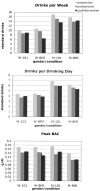Computer versus in-person intervention for students violating campus alcohol policy
- PMID: 19170455
- PMCID: PMC2657221
- DOI: 10.1037/a0014281
Computer versus in-person intervention for students violating campus alcohol policy
Abstract
In this study, the authors evaluated the efficacy of a brief motivational intervention (BMI) and a computerized program for reducing drinking and related problems among college students sanctioned for alcohol violations. Referred students (N = 198, 46% women), stratified by gender, were randomly assigned to a BMI or to the Alcohol 101 Plus computer program. Data obtained at baseline, 1, 6, and 12 months were used to evaluate intervention efficacy. Planned analyses revealed 3 primary findings. First, women who received the BMI reduced drinking more than did women who received the computer intervention; in contrast, men's drinking reductions did not differ by condition. Second, readiness to change and hazardous drinking status predicted drinking reductions at 1 month postintervention, regardless of intervention. Third, by 1 year, drinking returned to presanction (baseline) levels, with no differences in recidivism between groups. Exploratory analyses revealed an overall mean reduction in drinking immediately after the sanction event and before taking part in an intervention. Furthermore, after the self-initiated reductions prompted by the sanction were accounted for, participation in the BMI but not the computer intervention was found to produce additional reduction in drinking and related consequences.
Figures





References
-
- Abraham C, Sheeran P. The health belief model. In: Conner M, Norman P, editors. Predicting health behavior. 2. New York: Open University Press; 2007. pp. 28–80.
-
- Allen JP, Litten RZ, Fertig JB, Babor T. A review of research on the Alcohol Use Disorders Identification Test (AUDIT) Alcoholism: Clinical and Experimental Research. 1997;21:613–619. - PubMed
-
- Anderson DS, Gadaleto AF. Results of the 2000 College Alcohol Survey: Comparison with 1997 results and baseline year. Fair-fax, VA: George Mason University, Center for the Advancement of Public Health; 2001.
-
- Barnett NP, Read JP. Mandatory alcohol intervention for alcohol-abusing college students: A systematic review. Journal of Substance Abuse Treatment. 2005;29:147–158. - PubMed

